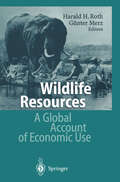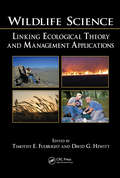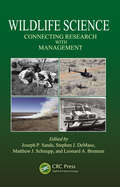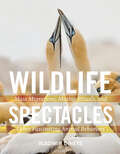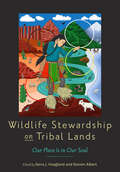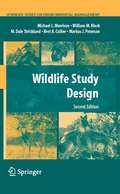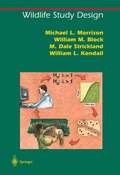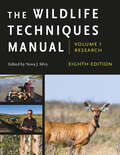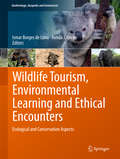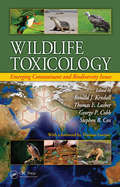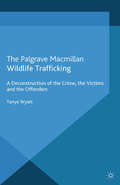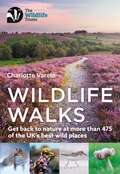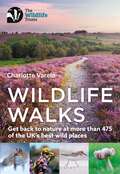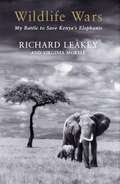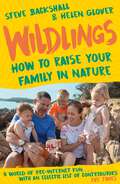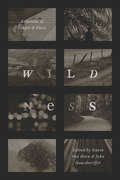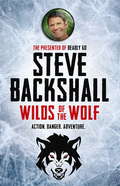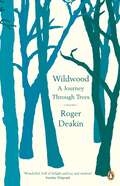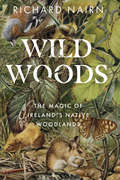- Table View
- List View
Wildlife Resources: A Global Account of Economic Use
by Harald H. RothThe general interest and attention paid to the use of the renewable natural resources of the world have increased greatly during the last decades. This is due to the environmental dilemma into which mankind has got itself by the total disregard of ecological facts and laws, the underprizing of natural resources and the overemphasis on economic develop ment, coupled with unimpeded rapid population growth and the preponderance of material istic consumption-oriented attitudes. The management and use of natural resources such as forests, grasslands, rivers and lakes were formerly considered purely in a financial context, whereas latterly, a consciousness of their social function and the indirect economic benefits which can be derived from them has developed. Thus, as regards these traditional resources, multi-use concepts comprising eco nomically oriented utilisation as well as recreational, educational and social use have be come widely accepted. Conservation of natural resources for sustainable consumptive as well as non-consumptive uses has been recognised as a key element for maintaining eco nomic development all over the world. Fortunately, the industrialised countries have started to apply this principle themselves and in their technical and financial aid to the developing Third World countries. This is manifest from policy documents such as the World Bank Policy on Development of Wild Lands, issued in 1987.
Wildlife Science: Linking Ecological Theory and Management Applications
by Timothy E. Fulbright David G. HewittConsciously or not, wildlife managers generally act from a theoretical basis, although they may not be fully versed in the details or ramifications of that theory. In practice, the predictions of the practitioners sometimes prove more accurate than those of the theoreticians. Practitioners and theoreticians need to work together, but this proves di
Wildlife Science: Connecting Research with Management
by Joseph P. Sands Leonard A. Brennan Stephen J. DeMaso Matthew J. SchnuppDespite the potential synergy that can result from basing management applications on results from research, there is a polarization of cultures between wildlife managers and wildlife researchers. Wildlife Science: Connecting Research with Management provides strategies for bridging cultural and communication gaps between these groups.Contributors p
Wildlife Spectacles: Mass Migrations, Mating Rituals, and Other Fascinating Animal Behaviors
by Vladimir DinetsWildlife Spectacles is an awe-inspiring exploration of the most remarkable displays of animal behavior in North America. Zoologist Vladimir Dinets clearly explains the spectacles, why they happen, and where they can be seen in real life.
Wildlife Stewardship on Tribal Lands: Our Place Is in Our Soul
by Serra J. Hoagland Steven AlbertThis groundbreaking book brings together Native American and Indigenous scholars, wildlife managers, legal experts, and conservationists from dozens of tribes to share their wildlife stewardship philosophies, histories, principles, and practices.Tribes have jurisdiction over some of the healthiest wild areas in North America, collectively managing over 56 million acres of land. This is no accident: in addition to a deep reverence for the land and a strong history of environmental stewardship, Native peoples implement some of the best fish and wildlife preservation and management practices on the continent. Wildlife Stewardship on Tribal Lands is the first comprehensive resource dedicated to the voices and expertise of Native scholars and wildlife professionals. In its pages, nearly one hundred Native and non-native wildlife conservationists, managers, and their collaborators share lessons to guide wildlife professionals in how best to incorporate native methods and how to work effectively with tribal stakeholders. The authors cover topics that include:• Guidelines for conducting research on tribal lands• Traditional ecological knowledge-based management models• The cultural and ecological importance of key species• Legal battles for treaty rights, management authority, and funding• First foods and food sovereignty • Fisheries and migratory bird management• Tribal perspectives on the Endangered Species Act• A history of modern fish and wildlife management on tribal landsThe content of this book is not limited to the invaluable reports of research findings, explications of methodologies, and case studies. Capturing oral histories and spiritual knowledge through interviews with tribal leaders and the work of Native artists and writers honors the holistic awareness of the land offered to readers of this unique volume. Ultimately, the contributors to Wildlife Stewardship on Tribal Lands demonstrate how tribal practices are pivotal guideposts for those seeking to protect and harness our natural resources in ways that can help reverse grievous biodiversity losses and ensure the health of our environment for future generations.Contributors: Scott Aikin, Steven Albert, John Antonio, Dale Becker, Bethany Berger, Kimberly Blaeser, Arthur Blazer, Michael Blumm, Michael Brydge, Ashley Carlisle, Frank Cerno Jr., Sally Carufel Williams, Guy Charlton, Samuel Chischilly, Bob Christensen, Gerald Cobell, Cody Desautel, Lauren Divine, Douglas W. Dompier, Ramona Emerson, Kari Eneas, James Fall, Julian J. Fischer, James R. Floyd, James Gensaw Sr., Michael I. Goldstein, Kim Gottschalk, Shaun Grassel, E. Richard Hart, Dylan R. Hedden-Nicely, Caleb Hickman, Serra J. Hoagland, Kraig Holmes, Nathan Jim, R. Roy Johnson, Jovon Jojola, Tamra Jones, Emily Sylvan Kim, Winona LaDuke, Stacy Leeds, Crystal Leonetti, Aaron P. Lestenkof, Chip Livingston, Lorraine Marquez Eiler, Eric Mellink, Paul I. Melovidov, Lara Mengak, Gary Paul Nabhan, Liliana Naves, Vern Northrup, nila northSun, Raymond E. Paddock III, Lizzy Pennock, Nicole Marie Pete, Aaron Poe, Georgiana Pongyesva, Ken Poynter, Mathis Quintana, Seafha Ramos, Janisse Ray, Vanessa L. Ray-Hodge, Amadeo Rea, Mitzi Reed, Marcie Rendon, Sarah F. Rinkevich, Bruce Robson, Andrea Rogers, Thomas C. Rothe, David E. Safine, Patty Schwalenberg, Kyle Secakuku, John Sewall, Todd Sformo, Richard T. Sherman, Ron Skates, Arthur M. Soukkala, Lawrence Stevens, Juliana Suzukawa, Julie Thorstenson, Gloria Tom, Christopher Tran, Craig van der Heiden, John Wheeler, Jessica Wiarda, Tiana Williams-Claussen.
Wildlife Stewardship on Tribal Lands: Our Place Is in Our Soul
by Serra J. Hoagland and Steven AlbertThis groundbreaking book brings together Native American and Indigenous scholars, wildlife managers, legal experts, and conservationists from dozens of tribes to share their wildlife stewardship philosophies, histories, principles, and practices.Tribes have jurisdiction over some of the healthiest wild areas in North America, collectively managing over 56 million acres of land. This is no accident: in addition to a deep reverence for the land and a strong history of environmental stewardship, Native peoples implement some of the best fish and wildlife preservation and management practices on the continent. Wildlife Stewardship on Tribal Lands is the first comprehensive resource dedicated to the voices and expertise of Native scholars and wildlife professionals. In its pages, nearly one hundred Native and non-native wildlife conservationists, managers, and their collaborators share lessons to guide wildlife professionals in how best to incorporate native methods and how to work effectively with tribal stakeholders. The authors cover topics that include:• Guidelines for conducting research on tribal lands• Traditional ecological knowledge-based management models• The cultural and ecological importance of key species• Legal battles for treaty rights, management authority, and funding• First foods and food sovereignty • Fisheries and migratory bird management• Tribal perspectives on the Endangered Species Act• A history of modern fish and wildlife management on tribal landsThe content of this book is not limited to the invaluable reports of research findings, explications of methodologies, and case studies. Capturing oral histories and spiritual knowledge through interviews with tribal leaders and the work of Native artists and writers honors the holistic awareness of the land offered to readers of this unique volume. Ultimately, the contributors to Wildlife Stewardship on Tribal Lands demonstrate how tribal practices are pivotal guideposts for those seeking to protect and harness our natural resources in ways that can help reverse grievous biodiversity losses and ensure the health of our environment for future generations.Contributors: Scott Aikin, Steven Albert, John Antonio, Dale Becker, Bethany Berger, Kimberly Blaeser, Arthur Blazer, Michael Blumm, Michael Brydge, Ashley Carlisle, Frank Cerno Jr., Sally Carufel Williams, Guy Charlton, Samuel Chischilly, Bob Christensen, Gerald Cobell, Cody Desautel, Lauren Divine, Douglas W. Dompier, Ramona Emerson, Kari Eneas, James Fall, Julian J. Fischer, James R. Floyd, James Gensaw Sr., Michael I. Goldstein, Kim Gottschalk, Shaun Grassel, E. Richard Hart, Dylan R. Hedden-Nicely, Caleb Hickman, Serra J. Hoagland, Kraig Holmes, Nathan Jim, R. Roy Johnson, Jovon Jojola, Tamra Jones, Emily Sylvan Kim, Winona LaDuke, Stacy Leeds, Crystal Leonetti, Aaron P. Lestenkof, Chip Livingston, Lorraine Marquez Eiler, Eric Mellink, Paul I. Melovidov, Lara Mengak, Gary Paul Nabhan, Liliana Naves, Vern Northrup, nila northSun, Raymond E. Paddock III, Lizzy Pennock, Nicole Marie Pete, Aaron Poe, Georgiana Pongyesva, Ken Poynter, Mathis Quintana, Seafha Ramos, Janisse Ray, Vanessa L. Ray-Hodge, Amadeo Rea, Mitzi Reed, Marcie Rendon, Sarah F. Rinkevich, Bruce Robson, Andrea Rogers, Thomas C. Rothe, David E. Safine, Patty Schwalenberg, Kyle Secakuku, John Sewall, Todd Sformo, Richard T. Sherman, Ron Skates, Arthur M. Soukkala, Lawrence Stevens, Juliana Suzukawa, Julie Thorstenson, Gloria Tom, Christopher Tran, Craig van der Heiden, John Wheeler, Jessica Wiarda, Tiana Williams-Claussen.
Wildlife Study Design (Springer Series on Environmental Management)
by Michael L. Morrison William M. Block M. Dale Strickland Bret A. Collier Markus J. PetersonWe developed the first edition of this book because we perceived a need for a compilation on study design with application to studies of the ecology, conser- tion, and management of wildlife. We felt that the need for coverage of study design in one source was strong, and although a few books and monographs existed on some of the topics that we covered, no single work attempted to synthesize the many facets of wildlife study design. We decided to develop this second edition because our original goal – synthesis of study design – remains strong, and because we each gathered a substantial body of new material with which we could update and expand each chapter. Several of us also used the first edition as the basis for workshops and graduate teaching, which provided us with many valuable suggestions from readers on how to improve the text. In particular, Morrison received a detailed review from the graduate s- dents in his “Wildlife Study Design” course at Texas A&M University. We also paid heed to the reviews of the first edition that appeared in the literature.
Wildlife Study Design (Springer Series on Environmental Management)
by Michael L. Morrison W.L. Kendall William M. Block M. Dale StricklandWildlife Study Design is a comprehensive guide to all aspects of study design. It including a survey of major types of studies and variables, impact assessment, sampling techniques, inventorying and monitoring, and analysis of data. The book includes a practical, step-by-step guide to setting up a new study. Minimal mathematical notation and examples drawn from field research make applied animal ecology both accessible and relevant. Resource managers, researchers, and students of wildlife and conservation biology will find this book a fundamental resource for implementing and evaluating appropriate studies.
The Wildlife Techniques Manual: Volume 1: Research. Volume 2: Management
by Nova J. SilvySince its original publication in 1960, The Wildlife Techniques Manual has remained the cornerstone text for the professional wildlife biologist. Now fully revised and updated, this eighth edition promises to be the most comprehensive resource on wildlife biology, conservation, and management for years to come. Superbly edited by Nova J. Silvy and published in association with The Wildlife Society, the 50 authoritative chapters included in this work provide a full synthesis of methods used in the field and laboratory. Chapter authors, all leading wildlife professionals, explain and critique traditional and new methodologies and offer thorough discussions of a wide range of relevant topics. To effectively incorporate the explosion of new information in the wildlife profession, this latest edition is logically organized into a 2-volume set: Volume 1 is devoted to research techniques and Volume 2 focuses on pragmatic management methodologies. Volume 1 describes research design and proper analytic methods prior to conducting research, as well as methods and considerations for capturing and handling wild animals and information on identification and marking of captured animals. It also includes new chapters on nutritional research and field sign identification, and on emerging topics, including structured decision-making. Finally, Volume 1 addresses measurements of wildlife abundance and habitat and research on individual animals. Volume 2 begins with a section on the relationship between research and management including public outreach, described in a context that encourages engagement prior to initiation of management. An adaptive management approach is described as a cornerstone of natural resource management, followed by a section on managing landscapes and wildlife populations. The volume also includes new chapters on ethics in wildlife science and conservation, conflict resolution and management, and land reclamation. A standard text in a variety of courses, the Techniques Manual, as it is commonly called, covers every aspect of modern wildlife management and provides practical information for applying the hundreds of methods described in its pages. This deft and thorough update ensures that The Wildlife Techniques Manual will remain an indispensable resource, one that professionals and students in wildlife biology, conservation, and management simply cannot do without.
Wildlife Tourism, Environmental Learning and Ethical Encounters: Ecological and Conservation Aspects (Geoheritage, Geoparks and Geotourism)
by Ismar Borges de Lima Ronda J. GreenThis book outlines the status quo of worldwide wildlife tourism and its impacts on planning, management, knowledge, awareness, behaviour and attitudes related to wildlife encounters. It sets out to fill the considerable gaps in our knowledge on wildlife tourism, applied ecology, and environmental education, providing comprehensive information on and an interdisciplinary approach to effective management in wildlife tourism. Examining the intricacies, challenges, and lessons learned in a meaningful and rewarding tourism niche, this interdisciplinary book comprehensively examines the major potentials and controversies in the wildlife tourism industry. Pursuing an insightful, provocative and hands-on approach, it primarily addresses two questions: ‘Can we reconcile the needs of the wildlife tourism industry, biodiversity conservation, ecological learning and animal ethics issues?’ and ‘What is the Future of the Wildlife Tourism Industry?’. Though primarily intended as a research text, it also offers a valuable resource for a broad readership, which includes university and training students, researchers, scholars, tourism practitioners and professionals, planners and managers, as well as the staff of government agencies.
Wildlife Toxicology: Emerging Contaminant and Biodiversity Issues
by Ronald J. Kendall Thomas E. Lacher George C. Cobb Stephen Boyd CoxUpdating the extremely successful Wildlife Toxicology and Population Modeling (CRC Press, 1994), Wildlife Toxicology: Emerging Contaminant and Biodiversity Issues brings together a distinguished group of international contributors, who provide a global assessment of a range of environmental stressors, including pesticides, environmental contaminant
Wildlife Trafficking: A Deconstruction of the Crime, the Victims, and the Offenders (Critical Criminological Perspectives)
by T. WyattThis book provides a unique, comprehensive exploration of the scale, scope, threats and drivers of wildlife trafficking. It also undertakes a distinctive exploration of who the victims and offenders of wildlife trafficking are as well as analysing the stakeholders who are involved in collaborative efforts to end this devastating green crime.
Wildlife Walks: Get back to nature at more than 475 of the UK's best wild places
by Charlotte VarelaThe definitive guide to Britain's stunning wildlife heritage, showcasing more than 475 walks through the Wildlife Trust's forest, heaths, moors and woods. Published in conjunction with the Wildlife Trusts, Wildlife Walks is a superb guide to more than 475 of the UK's top nature reserves, all of them owned and managed by the unique network of Wildlife Trusts.Organised by region, each entry includes information on access and conditions, opening times, facilities, how to get there, and local attractions. Boxes highlighting special species of interest are dotted throughout the book. Illustrated throughout with many beautiful colour photographs and maps, Wildlife Walks is the only guide you'll need to plan a great family day out.
Wildlife Walks: Get back to nature at more than 475 of the UK's best wild places
by Charlotte VarelaThe definitive guide to Britain's stunning wildlife heritage, showcasing more than 475 walks through the Wildlife Trust's forest, heaths, moors and woods. Published in conjunction with the Wildlife Trusts, Wildlife Walks is a superb guide to more than 475 of the UK's top nature reserves, all of them owned and managed by the unique network of Wildlife Trusts.Organised by region, each entry includes information on access and conditions, opening times, facilities, how to get there, and local attractions. Boxes highlighting special species of interest are dotted throughout the book. Illustrated throughout with many beautiful colour photographs and maps, Wildlife Walks is the only guide you'll need to plan a great family day out.
Wildlife Wars: My Fight To Save Africa's Natural Treasures
by Richard LeakeyRichard Leakey spent years trying to save Africa's animals. Now he's trying to save a nation. Leakey began his career following in the footsteps of his famous parents, Mary and Louis, and becoming a renowned paleoanthropologist and head of Kenya's National Museums. In 1989, Kenyan president Daniel arap Moi put Leakey in charge of the Kenyan Wildlife Service. Ivory poachers were killing hundreds of elephants annually and the organisation was close to collapse. Leakey sacked corrupt rangers and brought in millions of dollars from international donors to help enforce a ban on the ivory trade. But when Moi accused the service of corruption, Leakey quit, later forming an opposition party. He clashed with Moi but in July 1999, Moi appointed him head of Kenya's civil service and secretary to the Cabinet. He is now charged with ridding the government of corruption and jumpstarting the economy.Leakey's clashes with poachers and the dictator Moi will provide a dramatic focus for the book. He will also detail the challenge he faced when he lost both his legs in a plane crash that many believe to have been caused by sabotage. He has had over 30 operations to allow him to walk again.
Wildlings: How to raise your family in nature
by Steve Backshall Helen GloverThe ultimate handbook for raising wilder, happier, muddier, more resilient kids - whatever the weather and wherever you live.In the last few years parents everywhere have realised how crucial the freedom of the outside world is, not only for their kids' wellbeing, but the whole family's. They've also realised, however, that it's not always that easy. That's where this book comes in. Taking you through different environments and activities to explore, from minibeasts in the garden and pond dipping all the way through to beach Olympics and sea swimming (via rainy days, wild woods and river exploration), there are ideas small and big for all ages that will get them - and you - more engaged and involved with nature, and the wildlife in it.With contributions from;Bear Grylls on embracing adventure, Ed Stafford on flirting with danger , Sir Chris Hoy on riding bikes, Judy Murray on rainy day kitchen games, Michaela Strachan on creative word games, Gordon Buchanan on toasting marshmallows, Caroline Lucas on protecting the planet, Wayne Bridge on garden football,and many more, Wildlings is a map to a more adventurous, wilder future.
Wildness: Relations of People and Place
by Gavin Van Horn and John Hausdoerffer John HausdoerfferWhether referring to a place, a nonhuman animal or plant, or a state of mind, wild indicates autonomy and agency, a will to be, a unique expression of life. Yet two contrasting ideas about wild nature permeate contemporary discussions: either that nature is most wild in the absence of a defiling human presence, or that nature is completely humanized and nothing is truly wild. This book charts a different path. Exploring how people can become attuned to the wild community of life and also contribute to the well-being of the wild places in which we live, work, and play, Wildness brings together esteemed authors from a variety of landscapes, cultures, and backgrounds to share their stories about the interdependence of everyday human lifeways and wildness. As they show, far from being an all or nothing proposition, wildness exists in variations and degrees that range from cultivated soils to multigenerational forests to sunflowers pushing through cracks in a city alley. Spanning diverse geographies, these essays celebrate the continuum of wildness, revealing the many ways in which human communities can nurture, adapt to, and thrive alongside their wild nonhuman kin. From the contoured lands of Wisconsin’s Driftless region to remote Alaska, from the amazing adaptations of animals and plants living in the concrete jungle to indigenous lands and harvest ceremonies, from backyards to reclaimed urban industrial sites, from microcosms to bioregions and atmospheres, manifestations of wildness are everywhere. With this book, we gain insight into what wildness is and could be, as well as how it might be recovered in our lives—and with it, how we might unearth a more profound, wilder understanding of what it means to be human. Wildness: Relations of People and Place is published in association with the Center for Humans and Nature, an organization that brings together some of the brightest minds to explore and promote human responsibilities to each other and the whole community of life. Visit the Center for Humans and Nature's Wildness website for upcoming events and a series of related short films.
Wildness: Relations of People and Place
by Gavin Van Horn and John Hausdoerffer John HausdoerfferWhether referring to a place, a nonhuman animal or plant, or a state of mind, wild indicates autonomy and agency, a will to be, a unique expression of life. Yet two contrasting ideas about wild nature permeate contemporary discussions: either that nature is most wild in the absence of a defiling human presence, or that nature is completely humanized and nothing is truly wild. This book charts a different path. Exploring how people can become attuned to the wild community of life and also contribute to the well-being of the wild places in which we live, work, and play, Wildness brings together esteemed authors from a variety of landscapes, cultures, and backgrounds to share their stories about the interdependence of everyday human lifeways and wildness. As they show, far from being an all or nothing proposition, wildness exists in variations and degrees that range from cultivated soils to multigenerational forests to sunflowers pushing through cracks in a city alley. Spanning diverse geographies, these essays celebrate the continuum of wildness, revealing the many ways in which human communities can nurture, adapt to, and thrive alongside their wild nonhuman kin. From the contoured lands of Wisconsin’s Driftless region to remote Alaska, from the amazing adaptations of animals and plants living in the concrete jungle to indigenous lands and harvest ceremonies, from backyards to reclaimed urban industrial sites, from microcosms to bioregions and atmospheres, manifestations of wildness are everywhere. With this book, we gain insight into what wildness is and could be, as well as how it might be recovered in our lives—and with it, how we might unearth a more profound, wilder understanding of what it means to be human. Wildness: Relations of People and Place is published in association with the Center for Humans and Nature, an organization that brings together some of the brightest minds to explore and promote human responsibilities to each other and the whole community of life. Visit the Center for Humans and Nature's Wildness website for upcoming events and a series of related short films.
Wildness: Relations of People and Place
by Gavin Van Horn and John Hausdoerffer John HausdoerfferWhether referring to a place, a nonhuman animal or plant, or a state of mind, wild indicates autonomy and agency, a will to be, a unique expression of life. Yet two contrasting ideas about wild nature permeate contemporary discussions: either that nature is most wild in the absence of a defiling human presence, or that nature is completely humanized and nothing is truly wild. This book charts a different path. Exploring how people can become attuned to the wild community of life and also contribute to the well-being of the wild places in which we live, work, and play, Wildness brings together esteemed authors from a variety of landscapes, cultures, and backgrounds to share their stories about the interdependence of everyday human lifeways and wildness. As they show, far from being an all or nothing proposition, wildness exists in variations and degrees that range from cultivated soils to multigenerational forests to sunflowers pushing through cracks in a city alley. Spanning diverse geographies, these essays celebrate the continuum of wildness, revealing the many ways in which human communities can nurture, adapt to, and thrive alongside their wild nonhuman kin. From the contoured lands of Wisconsin’s Driftless region to remote Alaska, from the amazing adaptations of animals and plants living in the concrete jungle to indigenous lands and harvest ceremonies, from backyards to reclaimed urban industrial sites, from microcosms to bioregions and atmospheres, manifestations of wildness are everywhere. With this book, we gain insight into what wildness is and could be, as well as how it might be recovered in our lives—and with it, how we might unearth a more profound, wilder understanding of what it means to be human. Wildness: Relations of People and Place is published in association with the Center for Humans and Nature, an organization that brings together some of the brightest minds to explore and promote human responsibilities to each other and the whole community of life. Visit the Center for Humans and Nature's Wildness website for upcoming events and a series of related short films.
Wildness: Relations of People and Place
by Gavin Van Horn John HausdoerfferWhether referring to a place, a nonhuman animal or plant, or a state of mind, wild indicates autonomy and agency, a will to be, a unique expression of life. Yet two contrasting ideas about wild nature permeate contemporary discussions: either that nature is most wild in the absence of a defiling human presence, or that nature is completely humanized and nothing is truly wild. This book charts a different path. Exploring how people can become attuned to the wild community of life and also contribute to the well-being of the wild places in which we live, work, and play, Wildness brings together esteemed authors from a variety of landscapes, cultures, and backgrounds to share their stories about the interdependence of everyday human lifeways and wildness. As they show, far from being an all or nothing proposition, wildness exists in variations and degrees that range from cultivated soils to multigenerational forests to sunflowers pushing through cracks in a city alley. Spanning diverse geographies, these essays celebrate the continuum of wildness, revealing the many ways in which human communities can nurture, adapt to, and thrive alongside their wild nonhuman kin. From the contoured lands of Wisconsin’s Driftless region to remote Alaska, from the amazing adaptations of animals and plants living in the concrete jungle to indigenous lands and harvest ceremonies, from backyards to reclaimed urban industrial sites, from microcosms to bioregions and atmospheres, manifestations of wildness are everywhere. With this book, we gain insight into what wildness is and could be, as well as how it might be recovered in our lives—and with it, how we might unearth a more profound, wilder understanding of what it means to be human. Wildness: Relations of People and Place is published in association with the Center for Humans and Nature, an organization that brings together some of the brightest minds to explore and promote human responsibilities to each other and the whole community of life. Visit the Center for Humans and Nature's Wildness website for upcoming events and a series of related short films.
Wildness: Relations of People and Place
by Gavin Van Horn John HausdoerfferWhether referring to a place, a nonhuman animal or plant, or a state of mind, wild indicates autonomy and agency, a will to be, a unique expression of life. Yet two contrasting ideas about wild nature permeate contemporary discussions: either that nature is most wild in the absence of a defiling human presence, or that nature is completely humanized and nothing is truly wild. This book charts a different path. Exploring how people can become attuned to the wild community of life and also contribute to the well-being of the wild places in which we live, work, and play, Wildness brings together esteemed authors from a variety of landscapes, cultures, and backgrounds to share their stories about the interdependence of everyday human lifeways and wildness. As they show, far from being an all or nothing proposition, wildness exists in variations and degrees that range from cultivated soils to multigenerational forests to sunflowers pushing through cracks in a city alley. Spanning diverse geographies, these essays celebrate the continuum of wildness, revealing the many ways in which human communities can nurture, adapt to, and thrive alongside their wild nonhuman kin. From the contoured lands of Wisconsin’s Driftless region to remote Alaska, from the amazing adaptations of animals and plants living in the concrete jungle to indigenous lands and harvest ceremonies, from backyards to reclaimed urban industrial sites, from microcosms to bioregions and atmospheres, manifestations of wildness are everywhere. With this book, we gain insight into what wildness is and could be, as well as how it might be recovered in our lives—and with it, how we might unearth a more profound, wilder understanding of what it means to be human. Wildness: Relations of People and Place is published in association with the Center for Humans and Nature, an organization that brings together some of the brightest minds to explore and promote human responsibilities to each other and the whole community of life. Visit the Center for Humans and Nature's Wildness website for upcoming events and a series of related short films.
Wildness: Relations of People and Place
Whether referring to a place, a nonhuman animal or plant, or a state of mind, wild indicates autonomy and agency, a will to be, a unique expression of life. Yet two contrasting ideas about wild nature permeate contemporary discussions: either that nature is most wild in the absence of a defiling human presence, or that nature is completely humanized and nothing is truly wild. This book charts a different path. Exploring how people can become attuned to the wild community of life and also contribute to the well-being of the wild places in which we live, work, and play, Wildness brings together esteemed authors from a variety of landscapes, cultures, and backgrounds to share their stories about the interdependence of everyday human lifeways and wildness. As they show, far from being an all or nothing proposition, wildness exists in variations and degrees that range from cultivated soils to multigenerational forests to sunflowers pushing through cracks in a city alley. Spanning diverse geographies, these essays celebrate the continuum of wildness, revealing the many ways in which human communities can nurture, adapt to, and thrive alongside their wild nonhuman kin. From the contoured lands of Wisconsin’s Driftless region to remote Alaska, from the amazing adaptations of animals and plants living in the concrete jungle to indigenous lands and harvest ceremonies, from backyards to reclaimed urban industrial sites, from microcosms to bioregions and atmospheres, manifestations of wildness are everywhere. With this book, we gain insight into what wildness is and could be, as well as how it might be recovered in our lives—and with it, how we might unearth a more profound, wilder understanding of what it means to be human. Wildness: Relations of People and Place is published in association with the Center for Humans and Nature, an organization that brings together some of the brightest minds to explore and promote human responsibilities to each other and the whole community of life. Visit the Center for Humans and Nature's Wildness website for upcoming events and a series of related short films.
Wilds of the Wolf: Book 3 (The Falcon Chronicles #3)
by Steve BackshallThe third book in THE FALCON CHRONICLES series from DEADLY 60 and LIVE AND DEADLY presenter Steve Backshall. Follow Saker and Sinter's quest to save the world's endangered animals in the frozen Arctic wilderness. Saker and Sinter escape by the skin of their teeth when their plan to sabotage a billionaire businessman plundering 'black gold' (natural oil and gas) and hunting wolves in the remote Siberia goes disastrously wrong. But they escape one kind of peril only to find themselves in an even more terrifying situation. Separated by blizzards and avalanches, they are lost in a breathtakingly beautiful but deadly frozen Arctic wilderness. Suffering from frostbite and hunger, listening to the wolves howl and the packs draw closer, it seems that this time they cannot possibly live to tell their tale.Steve Backshall is the hugely popular and fearless presenter of the BBC kids' series DEADLY 60 and LIVE AND DEADLY as well as star of BBC's Strictly Come Dancing 2014.
Wildwood: A Journey Through Trees
by Roger DeakinRoger Deakin's Wildwood is a much loved classic of nature writingWildwood is about the element wood, as it exists in nature, in our souls, in our culture and our lives.From the walnut tree at his Suffolk home, Roger Deakin embarks upon a quest that takes him through Britain, across Europe, to Central Asia and Australia, in search of what lies behind man's profound and enduring connection with wood and with trees.Meeting woodlanders of all kinds, he lives in shacks and cabins, travels in search of the wild apple groves of Kazakhstan, goes coppicing in Suffolk, swims beneath the walnut trees of the Haut-Languedoc, and hunts bush plums with Aboriginal women in the outback.Perfect for fans of Robert Macfarlane and Colin Tudge, Roger Deakin's unmatched exploration of our relationship with trees is autobiography, history, traveller's tale and incisive work in natural history. It will take you into the heart of the woods, where we go 'to grow, learn and change''Enthralling' Will Self, New Statesman'Extraordinary . . . some of the finest naturalist writing for many years' Independent'Masterful, fascinating, excellent' Guardian'An excellent read - lyrical and literate and full of social and historical insights of all kinds' Colin Tudge, Financial Times'Enchanting, very funny, every page carries a fascinating nugget. Should serve to make us appreciate more keenly all that we have here on earth . . . one of the greatest of all nature writers' Craig Brown, Mail on Sunday'Breathtaking, vividly written . . . reading Wildwood is an elegiac experience' Sunday TimesRoger Deakin, who died in August 2006, shortly after completing the manuscript for Wildwood, was a writer, broadcaster and film-maker with a particular interest in nature and the environment. He lived for many years in Suffolk, where he swam regularly in his moat, in the river Waveney and in the sea, in between travelling widely through the landscapes he writes about in Wildwood. He is the author of Waterlog, Wildwood and Notes from Walnut Tree Farm.
Wildwoods: The Magic of Ireland's Native Woodlands
by Richard NairnEcologist Richard Nairn has spent a lifetime studying – and learning from – nature. When an opportunity arose for him to buy a small woodland filled with mature native trees beside a fast-flowing river, he set about understanding all its moods and seasons, discovering its wildlife secrets and learning how to manage it properly.Wildwoods is a fascinating account of his journey over a typical year. Along the way, he uncovers the ancient roles of trees in Irish life, he examines lost skills such as coppicing and he explores new uses of woodlands for forest schools, foraging and rewilding. Ultimately, Wildwoods inspires all of us to pay attention to what nature can teach us.‘A book to inspire anyone who wants Ireland to grow more Irish trees.’ Michael Viney
